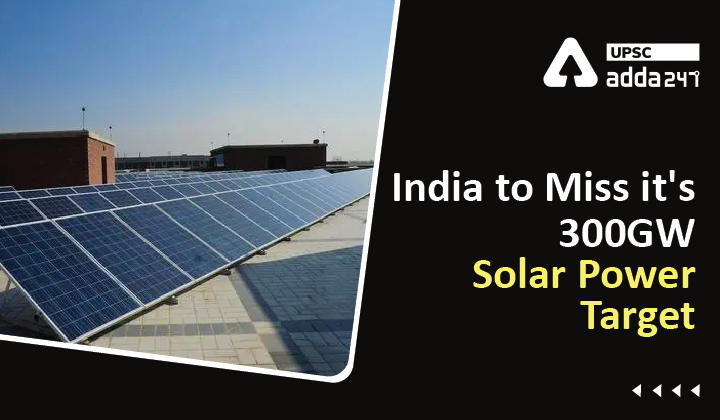Table of Contents
Solar Mission India UPSC: Relevance
- GS 3: Infrastructure: Energy, Ports, Roads, Airports, Railways etc.
National Solar Mission: Context
- In a recently released report by the Institute for Energy Economics and Financial Analysis (IEEFA) and JMK Research, it was found that India is likely to miss its solar energy target of 300 GW (gigawatt) for 2030 by around 86 GW.
India to miss solar mission targets: Key points
- The report has also said that India is expected to miss its goal of having 100 GW of installed solar capacity by about 27% this year.
- By December 2022, there is likely to be a shortfall of 25 GW from the 40 GW rooftop solar target, and 1.8 GW from the 60 GW utility-scale solar target.
- Only about 50% of the 100GW target, consisting of 60GW of utility-scale and 40GW of rooftop solar capacity, has been met.
- Reasons: Regulatory roadblocks, net metering limits, basic customs duty (BCD) on imported cells and modules, issues with the approved list of models and manufacturers (ALMM), unsigned power supply agreements (PSAs), banking restrictions.
Solar mission targets of India
- India launched National Solar Mission in 2010, under which the total installed capacity target was set at 20 GW by 2022. It marked the first time the government focussed on promoting and developing solar power in India.
- In 2015, government revised the target to 100GW, with no change in timeline.
- Again, in August 2021, the target was again increased, this time to 300GW by 2030.
India’s solar mission
- India currently ranks fifth after China, U.S., Japan and Germany in terms of installed solar power capacity.
- Between 2011 and 2021, the solar energy sector in India grew at a compound annual growth rate (CAGR) of 59% from 0.5 GW in 2011 to 55 GW in 2021.
- Solar power capacity has increased by more than 11 times in the last five years, from 2.6 GW in March 2014 to 30 GW in July 2019.
Importance of solar power in India
- Solar power forms a major component of India’s commitment to address global warming according to the terms of the Paris Agreement, as well as achieving net zero carbon emission by 2070.
- At the COP26, India committed of reaching a non-fossil fuel energy capacity of 500 GW by 2030 and meet half its energy requirements via renewable energy by 2030.
- Union government, in 2020, set a target of 450GW of RE-based installed capacity to be achieved by 2030, within which the target for solar was 300GW with an objective to boost the renewable energy installation drive in India.
Read current affairs for UPSC





 TSPSC Group 1 Question Paper 2024, Downl...
TSPSC Group 1 Question Paper 2024, Downl...
 TSPSC Group 1 Answer key 2024 Out, Downl...
TSPSC Group 1 Answer key 2024 Out, Downl...
 UPSC Prelims 2024 Question Paper, Downlo...
UPSC Prelims 2024 Question Paper, Downlo...




